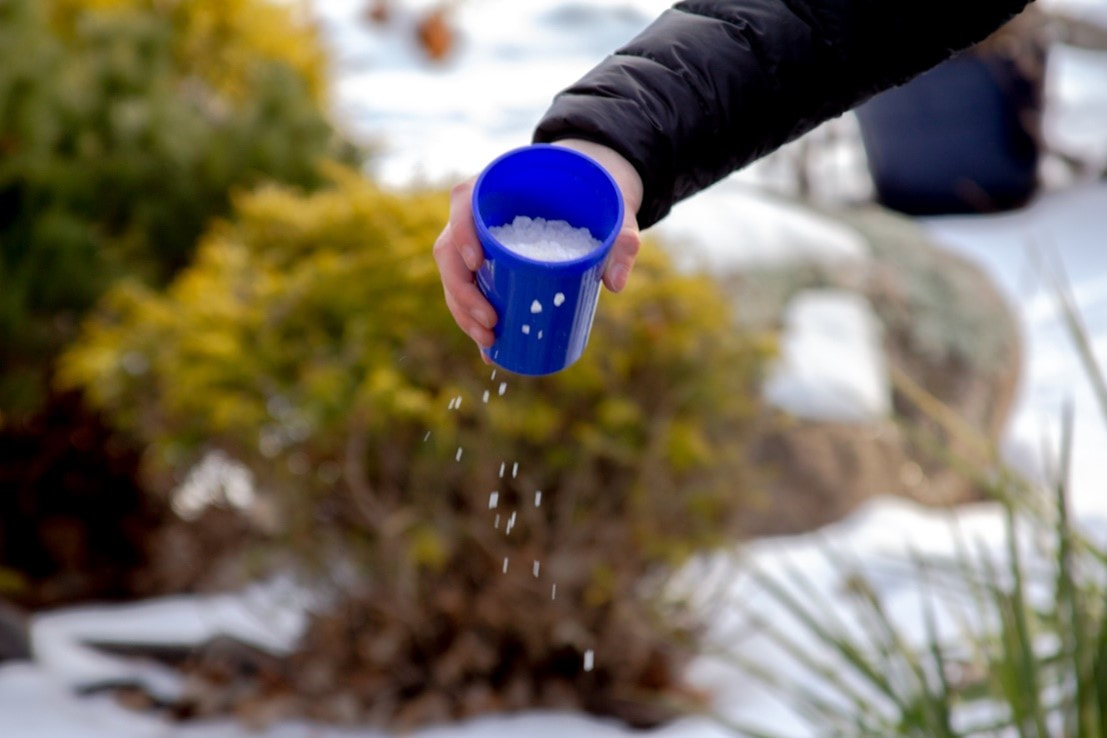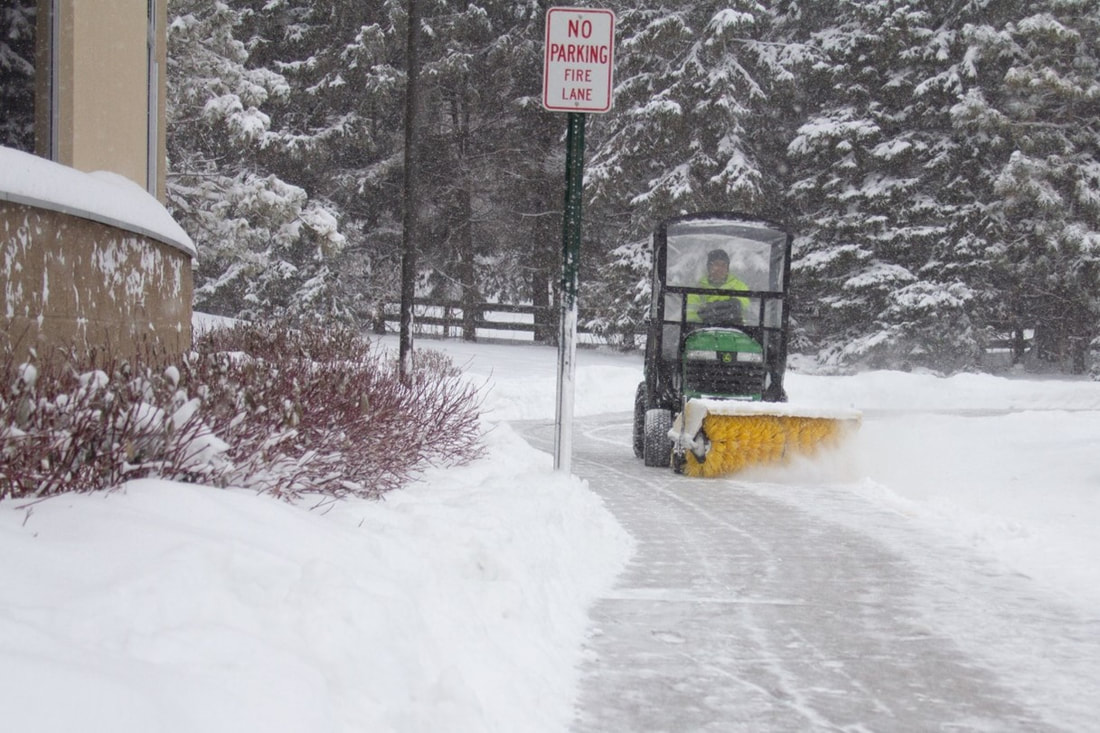The issue
Did you know that one teaspoon of salt pollutes 5 gallons of water FOREVER? When de-icing salt (a.k.a. chloride) enters bodies of water, there is no easy way to remove it.
Salt use has been on the rise since the 1950s, leading to waters becoming increasingly salty. Chloride levels have become so high that many creeks and lakes are now considered unhealthy and have been added to Minnesota’s impaired waters list for chloride pollution.
Luckily, there are actions we can take to help improve water quality. For example, Hennepin County has significantly decreased reliance on salt since the 1990s and continues to do so through better materials, better technology, better practices and more. Learn more about what the county is doing to keep water healthy and roadways safe.
Too much salt can lead to costly damages and environmental consequences! Chloride harms plants and animals, contaminates drinking water, damages buildings, and corrodes vehicles, roads and bridges.
We all want to prioritize safety, but it is critical to understand that more salt does not always mean less ice or safer conditions. Help protect our environment and infrastructure by practicing smart salting this winter.
New: salt reduction consultations available to faith-based organizations
WMWA is offering one-on-one consultations to faith-based organizations to address salt use and improve snow and ice management. This was developed using the Low Salt, No Salt Minnesota program. If you work with or are a member of a faith-based facility within the WMWA territory who would be interested in this personalized support, contact Grace Barcelow at [email protected] or 612-543-9295.
Actions you can take at home when managing snow and ice this winter:
1. Shovel as soon as possible after a snowstorm to prevent ice buildup.
2. Add an ice scraper to your toolbox. These are often more effective than salt when ice has built up on sidewalks and driveways.
3. Read the label on your deicer to make sure it will properly work in the current weather conditions. At low temperatures, typically colder than 15 degrees F, regular road salt will not melt ice.
4. Use sand or grit for traction when temperatures are too cold for salt to work.
5. Use salt sparingly. Generally, aim to have salt granules dispersed three inches apart.
Did you know that one teaspoon of salt pollutes 5 gallons of water FOREVER? When de-icing salt (a.k.a. chloride) enters bodies of water, there is no easy way to remove it.
Salt use has been on the rise since the 1950s, leading to waters becoming increasingly salty. Chloride levels have become so high that many creeks and lakes are now considered unhealthy and have been added to Minnesota’s impaired waters list for chloride pollution.
Luckily, there are actions we can take to help improve water quality. For example, Hennepin County has significantly decreased reliance on salt since the 1990s and continues to do so through better materials, better technology, better practices and more. Learn more about what the county is doing to keep water healthy and roadways safe.
Too much salt can lead to costly damages and environmental consequences! Chloride harms plants and animals, contaminates drinking water, damages buildings, and corrodes vehicles, roads and bridges.
We all want to prioritize safety, but it is critical to understand that more salt does not always mean less ice or safer conditions. Help protect our environment and infrastructure by practicing smart salting this winter.
New: salt reduction consultations available to faith-based organizations
WMWA is offering one-on-one consultations to faith-based organizations to address salt use and improve snow and ice management. This was developed using the Low Salt, No Salt Minnesota program. If you work with or are a member of a faith-based facility within the WMWA territory who would be interested in this personalized support, contact Grace Barcelow at [email protected] or 612-543-9295.
Actions you can take at home when managing snow and ice this winter:
1. Shovel as soon as possible after a snowstorm to prevent ice buildup.
2. Add an ice scraper to your toolbox. These are often more effective than salt when ice has built up on sidewalks and driveways.
3. Read the label on your deicer to make sure it will properly work in the current weather conditions. At low temperatures, typically colder than 15 degrees F, regular road salt will not melt ice.
4. Use sand or grit for traction when temperatures are too cold for salt to work.
5. Use salt sparingly. Generally, aim to have salt granules dispersed three inches apart.
Actions for property managers: Smart salting certification
The Minnesota Pollution Control Agency’s (MPCA) Smart Salting certification program trains state, city, and county road maintenance staff, private winter maintenance contractors, property management staff; and snowplow drivers about best practices to reduce their salt use while maintaining safety.
The MPCA also has statewide chloride resources, including a statewide chloride management plan, reports and guidance, model policies and ordinances, and educational resources.
See here for more frequently asked questions.
Water softeners also add salt to our water
Water softeners, which are used to reduce the hardness of water and help prevent mineral deposits on pipes, appliances, and glassware, also add salt to our water. Wastewater treatment plants are not designed to remove salt from water, meaning all that salt goes into our lakes and streams and contributes to chloride pollution.
Take the following actions to reduce the impact of water softeners:
For a list of cities that pre-soften water and more information on steps you can take, check out our water softener flyer.
For more information or any questions please contact:
Grace Barcelow
Conservation Specialist with WMWA and Hennepin County
612-543-9295
[email protected]
Pronouns: she/her
Water softeners, which are used to reduce the hardness of water and help prevent mineral deposits on pipes, appliances, and glassware, also add salt to our water. Wastewater treatment plants are not designed to remove salt from water, meaning all that salt goes into our lakes and streams and contributes to chloride pollution.
Take the following actions to reduce the impact of water softeners:
- Determine if you really need a water softener. Several cities in Hennepin County pre-soften water.
- Make sure you're using the right amount of salt to soften your water.
- Optimize the timer on your water softener or upgrade to a high efficiency water softener.
- Take steps to conserve water.
For a list of cities that pre-soften water and more information on steps you can take, check out our water softener flyer.
For more information or any questions please contact:
Grace Barcelow
Conservation Specialist with WMWA and Hennepin County
612-543-9295
[email protected]
Pronouns: she/her
Proudly powered by Weebly


